Going wild
Laura Gascoigne
Vincent van Gogh and Expressionism Van Gogh Museum, Amsterdam, until 4 March 2007
In November 1905, in the Galerie Ernst Arnold, four young architecture students from the Dresden Technical School had their first encounter with Vincent van Gogh. Only six months earlier, Ernst Ludwig Kirchner, Erich Heckel, Karl Schmidt-Rottluff and Fritz Bleyl had formed an avant-garde artists’ group, Die Brücke (The Bridge), to represent ‘all who express directly and truthfully what urges them to create’. At the sight of 54 paintings by van Gogh, remembered a teacher, they ‘went wild’.
The extraordinary impact of one man’s singular vision on the birth of modern art in Germany and Austria is the subject of an ambitious new exhibition at the Van Gogh Museum, Amsterdam. Vincent van Gogh and Expressionism unites 30 paintings and drawings by van Gogh with 60 works by Expressionist painters. Among those represented are the founder members of Die Brücke, later joined by Max Pechstein and Emil Nolde; the associates of Der Blaue Reiter, formed in Munich in 1911 by Wassily Kandinsky, Franz Marc and Gabriele Münter and later attracting August Macke, Alexej von Jawlensky and Paul Klee; and various non-affiliated Viennese Expressionists such as Gustav Klimt, Oskar Kokoschka, Egon Schiele and Richard Gerstl, plus Lovis Corinth and Otto Dix. In all, a grand total of 20 painters stylistically stamped with the DNA of the artist hailed by Pechstein as ‘the father of us all’.
How did a Dutchman who had died in obscurity in France less than 20 years earlier achieve such an ascendancy over German and Austrian art? For a start, it was a huge advantage not being French. For half a century the German art establishment had been fighting a losing battle against French influence: Impressionism was fine for France, but what the Germans needed was a national art expressive of the ‘German soul’. In the hybrid genius of this Francophile Dutchman, they found it.
Van Gogh’s madness also helped. True, Nolde initially found his work ‘a bit crazy’ and Klee’s first reaction was: ‘Permit me to be scared stiff.’ But to a newly urbanised generation of Germans, van Gogh’s intensely personal vision seemed to have something universal to say about modern life. The Expressionists took the visual vocabulary of a private madness, with its dizzying swirls, distortions and hallucinatory colour, and adapted it to general use. They splintered van Gogh’s ‘elongated pointillism’ into jagged shards and turned up his expressive colour to a fierce heat, using them to attack superficial representation and spearhead an expressive revolution in art.
The exhibition hang, in pairs and trios, accentuates colour harmonies and clashes, setting off the green pillbox hat of Max Pechstein’s ‘Young Woman with a Red Fan’ (c.1910) against the red fez of van Gogh’s ‘The Zouave’ (1888). Other links are established through line and brushwork: the robust handling of the foreground plane trees in van Gogh’s ‘The Road Menders’ (1889) has more to do with Franz Marc’s ‘Cats on a Red Cloth’ (1910) hanging alongside than with Nolde’s etiolated ‘White Tree Trunks’ (1908) upstairs. Some connections do seem a little forced: the two Klimt landscapes framing van Gogh’s ‘Daubigny’s Garden’ (1890) owe more to Seurat, but we’ll stretch a pointillist point.
Anyway, the differences are more telling than the similarities. Kirchner’s ‘Self-portrait with a Pipe’ (1907) is a direct rip-off of van Gogh’s ‘Self-portrait with a Straw Hat’ (and a pipe) of 1888, but a world away from it psychologically. Van Gogh’s picture portrays an ordinary working man seeking the consolations of tobacco; Kirchner’s depicts a self-conscious artist carving himself a place in art history with borrowed tools. In Schiele, the self-consciousness veers into self-caricature: the proto-punk ‘Self-portrait in a Brown Coat’ (1910) is a dead ringer for Richard E. Grant delivering Withnail’s immortal line: ‘I demand to have some booze.’ The sunflowers in Schiele’s recently rediscovered ‘Autumn Sun’ (1914) are a similarly jaundiced strain of the vibrant blooms in van Gogh’s famous vase: a straggly clump of bedraggled stalks set against the sickly pallor of a dying sun.
The differences say as much about history as about art. Van Gogh’s demons were in his head (though none the less terrifying for that); the Expressionists’ were real. Several saw action in the first world war: Kirchner suffered a breakdown, Kokoschka was badly wounded, Marc and Macke both lost their lives. In his ghastly ‘Sunrise’ of 1913, Dix transforms the vague dread of van Gogh’s ‘Wheatfield with Crows’ into full-blown horror. Beside the Expressionists, as one early critic remarked, van Gogh can sometimes look like ‘an innocent Academy professor’, perhaps because he was struggling to keep control while they were trying to lose it. Nevertheless, Franz Marc recognised in him ‘the most authentic, the greatest, the most poignant painter I know’ — and the point about authenticity, of course, is that it can’t be copied.



























































































 Previous page
Previous page